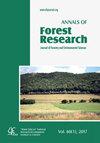The use of remote sensing indices derived from Sentinel 2 satellite images for the defoliation damage assessment of Lymantria dispar
IF 2.9
3区 农林科学
Q2 FORESTRY
引用次数: 0
Abstract
Monitoring and assessing the phytosanitary status of forests is a crucial activity in forest protection field, and the use of satellite remote sensing has become increasingly prevalent in this regard. Satellite images offer valuable information in terms of time and space, particularly through the analysis of vegetation and biophysical indices. Within this context, the aim of the study was to explore the potential of satellite remote sensing methods to monitor and assess the extent of tree defoliation caused by the gypsy moth (Lymantria dispar). The research study was focused on a forest situated in the Oltenia region of Romania, which experienced a gradation period for the defoliator L. dispar between 2018 and 2020. To determine the extent of defoliation caused by L. dispar in 2020 and 2021, a rectangular network consisting of 70 one-hectare sample areas was implemented. Each sample area had a square shape with a side of 100 m. In each corner of the sample areas, sub-sample circles with a radius of 12.62 meters were established, in which visual observations regarding the defoliation levels were conducted. The study involved a comparison between thematic maps derived from ground observations and those based on specific remote sensing indices derived through the processing of Sentinel 2 satellite images, of the Ciuturica forest area during the years 2020 and 2021. The research study indicated that the canopy water content (CWC) index was the most suitable for assessing defoliation caused by L. dispar. Furthermore, the study highlighted that remote sensing methods could be very effective and easily applicable, complementing the field ground-based efforts in monitoring and assessing the impact of L. dispar infestations.利用哨兵2号卫星图像遥感指数对毒蛾落叶危害进行评估
监测和评估森林植物检疫状况是森林保护领域的一项重要活动,卫星遥感在这方面的应用日益普遍。卫星图像提供了宝贵的时间和空间信息,特别是通过对植被和生物物理指数的分析。在此背景下,本研究的目的是探索卫星遥感方法在监测和评估舞毒蛾(Lymantria dispar)造成的树木落叶程度方面的潜力。该研究的重点是位于罗马尼亚Oltenia地区的一片森林,该森林在2018年至2020年期间经历了落叶虫L. dispar的渐变期。为了确定2020年和2021年白松引起的落叶程度,采用了由70个1公顷样区组成的矩形网络。每个样本区域为边长为100 m的正方形。在样区每个角落建立半径为12.62米的子样圈,对样区落叶程度进行目视观察。该研究比较了2020年和2021年期间由地面观测得出的专题地图与通过处理哨兵2号卫星图像得出的特定遥感指数绘制的丘图里卡森林地区专题地图。研究结果表明,冠层含水量(CWC)指数最适合用于评价白桦引起的落叶。此外,该研究强调,遥感方法可以非常有效和易于应用,补充了野外地面监测和评估L. dispar侵染影响的工作。
本文章由计算机程序翻译,如有差异,请以英文原文为准。
求助全文
约1分钟内获得全文
求助全文
来源期刊

Annals of Forest Research
FORESTRY-
CiteScore
2.20
自引率
11.10%
发文量
11
审稿时长
12 weeks
期刊介绍:
Annals of Forest Research is a semestrial open access journal, which publishes research articles, research notes and critical review papers, exclusively in English, on topics dealing with forestry and environmental sciences. The journal promotes high scientific level articles, by following international editorial conventions and by applying a peer-review selection process.
 求助内容:
求助内容: 应助结果提醒方式:
应助结果提醒方式:


